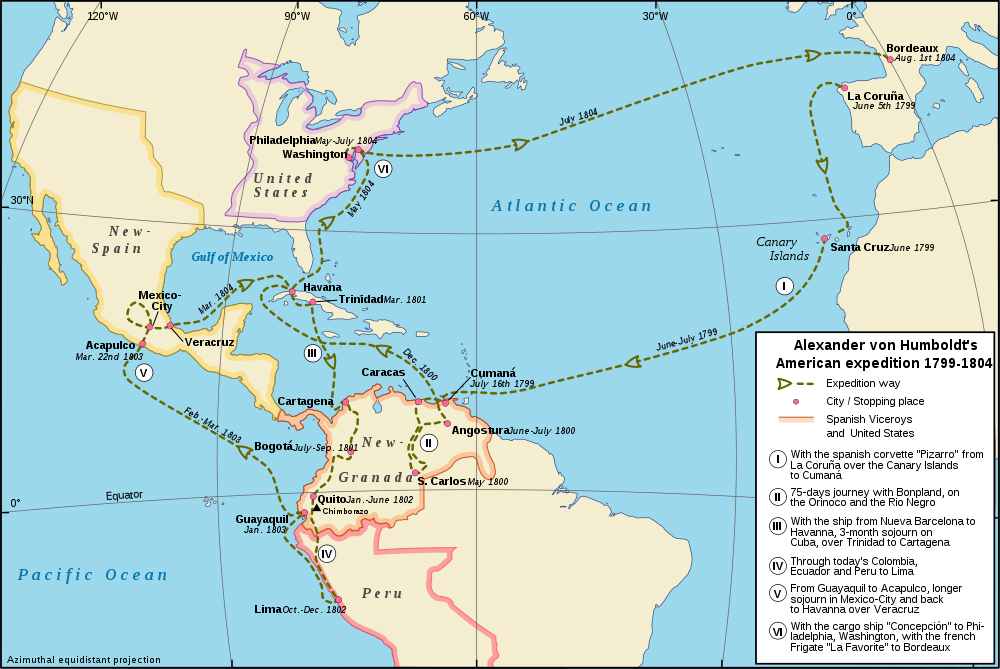Meeting 8 • 31 January 2013 • Thursday
|
Version: |
|
picture of the week |
thought-bite of the week: "Even when nature does not produce the same species in analogous climates,… we still noticed a striking resemblance of appearance and physiognomy in the vegetation of the most distant countries.… [R]eason cannot stop man forming hypotheses on the origin of things"(Humboldt, "Personal Narrative", from Jaguars and Electric Eels, ed. & trans. Wilson, p. 13) |
|
mini-text of the week (start): "The destruction of the forests… forcefully explains why the present Lake Valencia is decreasing.…"Humboldt, "Personal Narrative", from Jaguars and Electric Eels, ed. & trans. Wilson, p. 31 (read more) |
|
√ |
(5') Thought-bite of the week: Now that everybody (?) is on board the Humboldt SINQ Canoe, we'll get to the "sustainable environmentalism" part. Key points: "noticing" (observing, gathering data) and "forming hypotheses" (what does it mean, taken all together? - an early stage of evolutionary theory). Mini-text of the week: a very early systematic explanation of environmental damage and climate change. This week's theme: plants, and also food. |
|
√ |
(10') Followup about classification of species: Ungraded quiz: Which of these life-forms do you recognize when you encounter their biological (Latin! - with a little Japanese in one of them) names? - Ursus horribilis, Cannabis sativa, Pseudotsuga menziessi, Canis lupus (familiaris), Sphenicus humboldti, Metacarcinus magister (formerly Cancer magister), Bos primigenius, Sus domesticus (and farmer talk: "bossy" and "soo-ee"). Can you see and smell the difference between Quercus rubra and Quercus alba (sounds like a city in New Mexico, doesn't it)? Which of the above are / were (non-)native to Oregon / North America / The "New World"? Linnaean classification of a Humboldt-named species; why shellfish are called "shellFISH" but aren't actually fish (also: crawfish, crayfish, crawdad); illustration of a "type specimen" (C. humboldtiana); get ready to choose "your" Humboldt-named species. Can you see and smell the difference between quercus alba and quercus rufus How about a nice plate full of Dosidicus gigas (aka diablo rojo)? Should we offer the Humboldt-named schools a lesson plan organized around a banquet of Humboldt-named plants and animals? Maybe with a fund-raiser? Three newspaper / magazine articles about invasive species and the food industry: 0058 squid invasion; 0059 "squidding"; 0085 "Save the Ocean, Eat a Squid". Canoes, invasive species (zebra mussel), and Oregon law |
|
√ |
(20') SINQing the Humboldt canoe (wrapup, literally [learn how to use this word correctly]): The actual math: how big was it, and what couldit hold? Followup about the question one of you asked: "So did Humboldt actually calculate that all out when we was loading his canoe?" An example: "Alexander, Wie berechnest du die Größe von deinen Kanus? Alexandre, Le bateau ici - est-ce-que tu sais exactement s'il est assez grand?" And how did they figure out how much wood they needed for those boats and crates? They planned and calculated carefully; we have the expedition mission orders and packing lists of Cook and Lewis & Clark. Key concepts: displacement and density (Wikipedia: density); key fact: density / weight of (salt, fresh) water (Wikipedia: water weight) Use the map above and your computer/ smartphone map links and applications to trace AvH's route in South America, starting with his travel up the Orinoco and down the Amazon. See Helferich, p. 52 map, but be aware that some place names have been changed over time. importance of DATA (for Humboldt, for us; about Humboldt); example: how many position measurements did H make in a day? How many other measurements? |
|
+ |
(10') Review and expansion of quantification activities, with application to food. A story that includes a story problem: How do nursing mothers do it? Rough calculation vs. precise calculation. Relation to food and energy needs of explorers. What did Lewis & Clark and the "Party of Discovery" Eat? (some other time: what ate them). How does that compare to your diet? How is nutritional research conducted - how do we get, so to speak, a window into the stomach? see book review candidate Catching Fire: How Cooking Made Us Human |
| - |
(05') presentation (continuation) about educational standards and their parts in the course: 1) evaluating own education; 2) helping others to learn - how standards are used to develop curriculum (curricula?) and learning activities. Example of source of lesson plans; article (H0152) "School Gardens Blooming Teach Lessons On Nutrition, Environment, Science, Teamwork". This is preparation for assignments about species description and group projects |
|
+ |
(10') So now they're / we're / you're on board. We're just getting into the systematic discussion of sustainable environmentalism. We're finishing the basic reading (have you?), and now need to branch out for more reading. Choosing and signing out books for book review assignment; recommendations for some special topics: women in Humboldt's time; religion and science; books on the list that I don't have copies of (use library, etc.); examples of book reviews |
|
+ |
(5') Announcements, Checkups & Previews: 1) Comments about "Leaving Home" (structure, common errors, gems, mechanics, etc.) 2) Lyon Arboretum interested in working with us; 3) Next meeting: formation of project teams and survey of suggested |
